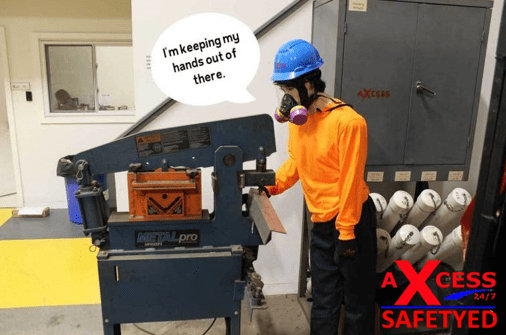PPE requirements vary depending on which part of your body might be exposed to hazards. Today we’ll discuss the different types of PPE.
Types of PPE:
- Hard hats and helmets
- Safety glasses, goggles, face shields
- Earplugs and earmuffs
- Gloves
- Coveralls and aprons
- Safety footwear
- Dust masks and respirators
A hard hat has a hard shell with a shock-absorbing liner or suspension system. It protects from blows to the head as well as guards against electrical shock and burns.
Eye or face protection helps protect from flying particles, molten metal, liquid chemicals, acids or caustic liquids, chemical gases or vapors, potentially infected material or potentially harmful light radiation. Types of eye and face protection include: Safety Glasses – Used for moderate impact from flying objects. Goggles – Protects eyes and area around the eyes from impact, dust, and splashes and includes laser safety goggles. Face Shields – Full face protection from dust and splashes or sprays of hazardous liquids Welding Shields/Helmets – Protect the eyes, face and neck from flash burn, ultraviolet light, sparks, infrared light, and heat.
Hearing protections protects against hazardous noise. Include: Earplugs – pliable material for insertion into the outer opening of the ear. Earmuffs – designed to fit around the external ear.
It is important to protect hands against injuries including burns, bruises, abrasions, cuts, punctures, and chemicals. Types of hand protection include: Durable gloves made of kevlar, leather, or canvas – protects against cuts, burns, heat, and abrasions. Fabric and coated fabric gloves – protects against dirt and abrasion. Chemical and liquid resistant gloves – protects from burns, irritation, and dermatitis.
Jeans and long-sleeve shirts are often adequate against minor hazards like dirt, nuisance dust, minor abrasions and sun exposure. Other types of body protection may include coveralls, jackets, vests, and aprons.
Foot protection can protect from falling or sharp objects, molten metal, corrosive chemicals, slippery surfaces, static-discharge or electric-shock. Types include: Metatarsal guards – protect the instep area from impact and compression Toe guards – fit over the toes of regular shoes to protect the toes from impact and compression hazards Safety shoes – have impact-resistant toes and heat-resistant soles that protect the feet against hot work surfaces Electrically conductive shoes – provide protection against the buildup of static electricity Electrical hazard, safety-toe shoes – are nonconductive and can prevent the wearers’ feet from completing an electrical circuit to the ground.

